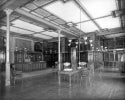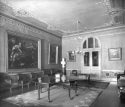Introduction
In conjunction with Jesuit Heritage Week 2006, Lauinger Library displayed items from its Archives and Manuscript Collections commemorating the life and work of the artist Brother Francis C. Schroen, S.J.
While completing her master’s thesis for a degree in liberal studies, long-time Secretary of the University Virginia Keeler conducted an in-depth study of Brother Schroen and the decorative work he completed in Healy Hall around the turn of the century. The Georgetown campus was just one of the places Brother Schroen worked as a member of the Jesuit order. Creating beautiful interiors, he earned a reputation as one of the most skilled decorators of his time.
The exhibit consists largely of photographs, old and new, of the decorative painting in rooms of Georgetown University's Healy Hall such as Carroll Parlor, Hirst Reading Room, and Gaston Hall. Included are items from Ms. Keeler’s research materials, which were donated to the library’s Special Collections after her death in 2004.
Virginia "Ginny" Mary Keeler (1932-2004)
This 1978 yearbook photo shows Virginia Keeler, who began working for Georgetown in 1953. She advanced to the position of Secretary of the University, the post which she held until her retirement in 1997. Seven years before she retired, she earned her master’s degree in liberal studies. She chose, for her thesis, to conduct an in depth study of Brother Francis C. Schroen, S.J., the artist who decorated the building in which she worked. In her project proposal she stated, “It would be the focus of my project to endeavor to collect on slides what survives of his work, and to explore his life.” After her death, her research papers, including 150 slides of Schroen’s work, were donated to the Special Collections of Georgetown University Library where they now reside as part of the Manuscripts Collections.
The Search for Freedom, and Freedom Found: The Life and Art of Brother Francis C. Schroen, S.J.
Master’s Thesis and Project Proposal submitted by Virginia M. Keeler to the School for Continuing Education, Georgetown University, 1989.
Brother Francis C. Schroen, S.J. (1857- 1924)
Born in Bavaria, Francis C. Schroen, S.J., was brought to Baltimore by his parents as an infant. His father was a tailor and wished Francis to enter the same field. However, after Francis left school, he worked as a house painter, earning a reputation as a skilled decorator who specialized in the use of plastics. After a series of tragedies – the death of two of his children and then of his wife in childbirth – and financial setbacks, he applied for admission as a Jesuit lay-brother. Continuing his decorating work as a member of the Jesuit order, he became one of the most noted church decorators and painters of his time. His talents were utilized at Georgetown, Fordham, and Boston College, in the Cathedral of Kingston, Jamaica, and in the Church of the Holy Name in New Orleans, among other places. Brother Schroen is buried in the Jesuit Community Cemetery on campus.
Brother Schroen and his daughter
This article from 1962 includes two images of Brother Schroen – one at work and one listening to daughter, Margaret Mary, playing the harp. Records in the University Archives indicate that Margaret Mary often played in Gaston Hall while her father worked on its decoration.
Gaston Hall as pictured in Georgetown
Summer 1990
Brother Schroen drew heavily on classical allegory in his work: “I have always planned to have every figure mean something. It must be symbolic even to the smallest scroll.” In Gaston, the crests of sixty Jesuit colleges and universities from around the world decorate the ceiling line. At either end of the stage wall, the painted figures of Athena and a classically draped male, accompanied by the phrases, mens sana and in corpore sano, respectively, represent the Jesuit precept of a sound mind in a sound body. But the central focus of the stage wall and, indeed, the Hall are the two large murals above the stage. These depict, to the left, Morality, Faith (holding a book displaying the Greek letters alpha and omega) and Patriotism, and, to the right, Art, Alma Mater, and Science. A significant feature of his work in Gaston – and the rest of his work at Georgetown – is that is was done freehand, without the use of a stencil. A newspaper account in 1902 noted that this:
. . . eliminates that mechanical exactness of repetition which detracts from the artistic value of the design, a feature which gives medieval ornamentation its peculiar beauty and value . . .
Hirst Reading Room
ca. 1910
Now home to the National Reference Center for Bioethics Literature, this space on the first floor of Healy Hall’s south wing has a classical revival air. The ceiling is elaborately painted. Coffers are formed by cross beams, fabricated from plaster, which Brother Schroen grained to look like oak. Set into each coffer are paintings in gilt frames. These represent the history of writing, depicting: Mexican ideographs; Japanese; the Vedas (the sacred books of ancient India); a Greek scroll; Babylonian bricks (cuneiform); Rock of Behistun (Persian); the Ruthwell cross (runes); Hieroglyphs; the Book of Ulfilas (Gothic); a Hebrew scroll; the Book of Kells; and the Douay Bible.
Carroll Parlor
ca. 1930.
Brother Schroen decorated the ceiling of Healy Hall’s Carroll Parlor with plaster applied in bas relief and then painted. In the words of Virginia Keeler the plaster was applied “much like icing on a cake, raising the decoration from the ceiling.”
Carroll Parlor
May 1989
The walls of Carroll Parlor have been returned to their original color of pink. A corner, shown here in detail, features the seal of the college and of the Jesuit order along with garlands of laurel and honeysuckle.
Healy Hall Parlor Corridor
ca. 1904
In addition to the ceiling and borders of the entrance hall, Brother Schroen decorated the adjacent rooms including Carroll Parlor (doorway to the left in this photo) and the parlor rooms which line the other side of the hall and are now offices for campus ministry.
Painting Renovations in the Parlor Corridor
July 1987
The walls of the hallway are now painted white, a change from the original blue, but the ceiling and border decorations have all been preserved and restored.
Detail of leaves, ceiling of Parlor Corridor
1987
According to Keeler, Brother Schroen carved these leaves freehand into the plaster. In her thesis she quotes Father Patrick Cormican, S.J. who explains that the decoration of the hall was an “introduction of the foliage of the most predominant species of trees which are the pride of the renowned college walks – the beech, the oak, the sycamore, the chestnut.”
Main staircase to the second floor of Healy Hall
For the decoration of the landing at the top of the staircase, already visually striking with two arched windows, Brother Schroen linked learning, scienti, and religion, religio, with the “Light of the World”, Lux Mundi, inscribed on a blazing torch above the seal of the Jesuit Order. In the reception area at the top of the stairs, he inscribed the Latin names of academic disciplines, including theology, history, philology, biology, chemistry, physics, mathematics, poetry, rhetoric, and medicine. They are framed by foliage carved in plaster.
The Church of the Holy Name of Jesus, New Orleans, Louisiana
October 1987
Virginia Keeler traveled to New Orleans in 1987 and visited the site of Brother Schroen’s last great work which he began in 1922. Schroen completed the project and returned to Georgetown University in 1924 ill with cancer. Keeler was hoping to find that his interior decorative work had survived the renovations of The Holy Name church, which is contiguous to the Loyola University campus. She was elated when she entered the sanctuary and confirmed that the paintings above the altar were indeed done by Brother Schroen. She writes in her thesis, “What still survives is the focus of the sanctuary, where the angels hold in their hands the words of the ‘Gloria in Excelsis Deo’ around the altar, with the rich red and gilt background.”
The Church of the Holy Name of Jesus, New Orleans, Louisiana
October 1987
Having survived the renovations of the church, the paintings, along with the entire city of New Orleans, were threatened in August 2005 when Hurricane Katrina came ashore. Fortunately the structure was not damaged, and the news we received from Laura Catherine Gallien, Associate Chaplain at Loyola University, was good: “The church is truly a New Orleans treasure, and we are happy to report that it survived Hurricane Katrina quite well!” The church was the site of the Loyola University Convocation held on January 6, 2006 which welcomed students back to campus for the reopening of the University.
Highly Decorated: The Work of Brother Francis C. Schroen, S.J. was prepared by Lynn Conway, University Archivist and Heidi Rubenstein, Manuscripts Processor.


















